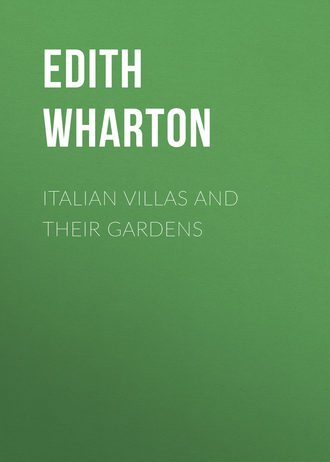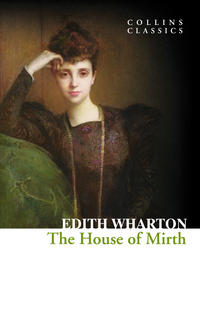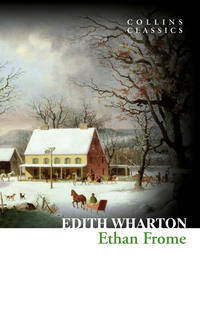 полная версия
полная версияItalian Villas and Their Gardens
The façade is a mere pretext for the display of the most exquisite and varied stucco ornamentation, in which motives borrowed from the Roman stucchi are harmonized with endless versatility. In spite of the wealth of detail, it is saved from heaviness and confusion by its delicacy of treatment and by a certain naïveté which makes it more akin (fantastic as the comparison may seem) with the stuccoed façade of San Bernardino at Perugia than with similar compositions of its own period. The angels or genii in the oblong panels are curiously suggestive of Agostino da Duccio, and the pale-yellow tarnished surface of the stucco recalls the delicate hues of the Perugian chapel.
The ground floor consists of an open loggia of three arches on columns, forming a kind of atrium curiously faced with an elaborate mosaic-work of tiny round pebbles, stained in various colours and set in arabesques and other antique patterns. The coigns of the façade are formed of this same mosaic—a last touch of fancifulness where all is fantastic. The barrel-vault of the atrium is a marvel of delicate stuccature, evidently inspired by the work of Giovanni da Udine at the Villa Madama; and at each end stands a splendid marble basin resting on winged griffins. The fragile decorations of this exquisite loggia are open on three sides to the weather, and many windows of the upper rooms (which are decorated in the same style) are unshuttered and have broken panes, so that this unique example of cinque-cento decoration is gradually falling into ruin from mere exposure. The steps of the atrium, flanked by marble Cupids on dolphins, lead to an oval paved court with a central fountain in which the Cupid-motive is repeated. This court is enclosed by a low wall with a seat running around it and surmounted by marble vases of a beautiful tazza-like shape. Facing the loggia, the wall is broken (as at the Villa di Papa Giulio) by a small pavilion resting on an open arcade, with an attic adorned with stucco panels; while at the sides, equidistant between the villa and the pavilion, are two vaulted porticoes, with façades like arches of triumph, by means of which access is obtained to curving ramps that lead to the lower level of the gardens. These porticoes are also richly adorned with stucco panels, and lined within with a mosaic-work of pebbles, forming niches for a row of busts.
From the central pavilion one looks down on a tank at its base (the pavilion being a story lower on its outer or garden side). This tank is surmounted by a statue of Thetis on a rock-work throne, in a niche formed in the basement of the pavilion. The tank encloses the pavilion on three sides, like a moat, and the water, gushing from three niches, overflows the low stone curb and drips on a paved walk slightly hollowed to receive it—a device producing a wonderful effect of coolness and superabundance of water.
The old gardens of the villa were on a level with the tank, and Falda’s print shows the ingenuity of their planning. These gardens have now been almost entirely destroyed, and the bosco above the villa has been cut down and replaced by bare grass-banks dotted with shrubs.
The Villa Pia has been thus minutely described, first, because it is seldom accessible, and consequently little known; but chiefly because it is virtually not a dwellinghouse, but a garden-house, and thus forms a part of the actual composition of the garden. As such it stands alone in Italian architecture, and Burckhardt, who notes how well its lavish ornament is suited to a little pleasure-pavilion in a garden, is right in describing it as the “most perfect retreat imaginable for a midsummer afternoon.”
The outer gardens of the Vatican, in a corner of which the Villa Pia lies, were probably laid out by Antonio da Sangallo the Younger, who died in 1546; and though much disfigured, they still show traces of their original plan. The sunny sheltered terrace, espaliered with lemons, is a good example of the “walk for the cold season” for which Italian garden-architects always provided; and the large sunken flower-garden surrounded by hanging woods is one of the earliest instances of this effective treatment of the giardino segreto. In fact, the Vatican may have suggested many features of the later Renaissance garden, with its wide-spread plan which gradually came to include the park.
The seventeenth century saw the development of this extended plan, but saw also the decline of the architectural restraint and purity of detail which mark the generation of Vignola and Sangallo. The Villa Borghese, built in 1618 by the Flemish architect Giovanni Vasanzia (John of Xanten), shows a complete departure from the old tradition. Its elevation may indeed be traced to the influence of the garden-front of the Villa Medici, which was probably the prototype of the gay pleasure-house in which ornamental detail superseded architectural composition; but the garden-architecture of the Villa Borghese, and the treatment of its extensive grounds, show the complete triumph of the baroque.
The grounds of the Villa Borghese, which include a park of several hundred acres, were laid out by Domenico Savino and Girolamo Rainaldi, while its waterworks are due to Giovanni Fontana, whose name is associated with the great jeux d’eaux of the villas at Frascati. Falda’s plan shows that the grounds about the house have been little changed. At each end of the villa is the oblong secret garden, not sunken but walled; in front an entrance-court, at the back an open space enclosed in a wall of clipped ilexes against which statues were set, and containing a central fountain. Beyond the left-hand walled garden are various dependencies, including an aviary. These little buildings, boldly baroque in style, surcharged with stucco ornament, and not without a certain Flemish heaviness of touch, have yet that gaiety, that imprévu, which was becoming the distinguishing note of Roman garden-architecture. On a larger scale they would be oppressive; but as mere garden-houses, with their leafy background, and the picturesque adjuncts of high walls, wrought-iron gates, vases and statues, they have an undeniable charm.
The plan of the Borghese park has been the subject of much discussion. Falda’s print shows only the vicinity of the villa, and it has never been decided when the outlying grounds were laid out and how much they have been modified. At present the park, with its romantic groves of umbrella-pine, its ilex avenues, lake and amphitheatre, its sham ruins and little buildings scattered on irregular grassy knolls, has the appearance of a jardin anglais laid out at the end of the eighteenth century. Herr Tuckermann, persuaded that this park is the work of Giovanni Fontana, sees in him the originator of the “sentimental” English and German landscape-gardens, with their hermitages, mausoleums and temples of Friendship; but Percier and Fontaine, from whose plan of the park his inference is avowedly drawn, state that the grounds were much modified in 1789 by Jacob Moore, an English landscape-gardener, and by Pietro Camporesi of Rome. Herr Gurlitt, who seems to have overlooked this statement, declares himself unable to pronounce on the date of this “creation already touched with the feeling of sentimentality”; but Burckhardt, who is always accurate, says that the hippodrome and the temple of Æsculapius are of late date, and that the park was remodelled in the style of Poussin’s landscapes in 1849.
About thirty years later than the Villa Borghese there arose its rival among the great Roman country-seats, the Villa Belrespiro or Pamphily, on the Janiculan. The Villa Pamphily, designed by Alessandro Algardi of Bologna, is probably the best known and most admired of Roman maisons de plaisance, and its incomparable ilex avenues and pine-woods, its rolling meadows and wide views over the Campagna, have enchanted many to whom its architectural beauties would not appeal.
The house, with its incrustations of antique bas-reliefs, cleverly adapted in the style of the Villa Medici, but with far greater richness and license of ornament, is a perfect example of the seventeenth-century villa, or rather casino; for it was really intended, not for a residence, but for a suburban lodge. It is flanked by lateral terraces, and the garden-front is a story lower than the other, so that the balcony of the first floor looks down on a great sunken garden, enclosed in the retaining-walls of the terraces, and richly adorned with statues in niches, fountains and parterres de broderie. Thence a double stairway descends to what was once the central portion of the gardens, a great amphitheatre bounded by ilex-woods, with a théâtre d’eaux and stately flights of steps leading up to terraced ilex-groves; but all this lower garden was turned into an English park in the first half of the nineteenth century. One of the finest of Roman gardens fell a sacrifice to this senseless change; for in beauty of site, in grandeur of scale, and in the wealth of its Roman sculpture, the Villa Pamphily was unmatched. Even now it is full of interesting fragments; but the juxtaposition of an undulating lawn and dotty shrubberies to the stately garden-architecture about the villa has utterly destroyed the unity of the composition.
There is a legend to the effect that Le Nôtre laid out the park of the Villa Pamphily when he came to Rome in 1678; but Percier and Fontaine, who declare that there is nothing to corroborate the story, point out that the Villa Pamphily was begun over thirty years before Le Nôtre’s visit. Absence of proof, however, means little to the average French author, eager to vindicate Le Nôtre’s claim to being the father not only of French, but of Italian landscape-architecture; and M. Riat, in “L’Art des Jardins,” repeats the legend of the Villa Pamphily, while Dussieux, in his “Artists Français à l’Etranger,” anxious to heap further honours on his compatriot, actually ascribes to him the plan of the Villa Albani, which was laid out by Pietro Nolli nearly two hundred years after Le Nôtre’s visit to Rome! Apparently the whole story of Le Nôtre’s laying out of Italian gardens is based on the fact that he remodelled some details of the Villa Ludovisi; but one need only compare the dates of his gardens with those of the principal Roman villas to see that he was the pupil and not the master of the great Italian garden-architects.
The last great country house built for a Roman cardinal is the villa outside the Porta Salaria which Carlo Marchionne built in 1746 for Cardinal Albani. In spite of its late date, the house still conforms to the type of Roman villa suburbana which originated with the Villa Medici; and it is interesting to observe that the Roman architects, having hit on so appropriate and original a style, did not fear to continue it in spite of the growing tendency toward a lifeless classicalism.
Cardinal Albani was a passionate collector of antique sculpture, and the villa, having been built to display his treasures, is appropriately planned with an open arcade between rusticated pilasters, which runs the whole length of the façade on the ground floor, and is continued by a long portico at each end. The grounds, laid out by Antonio Nolli, have been much extolled. Burckhardt sees in them traces of the reaction of French eighteenth-century gardening on the Italian school; but may it not rather be that, the Villa Albani being, by a rare exception, built on level ground, the site inevitably suggested a treatment similar to the French? It is hard to find anything specifically French, any motive which has not been seen again and again in Italy, in the plan of the Albani gardens; and their most charming feature, the long ilex-walk connecting the villa with the bosco, exemplifies the Italian habit of providing shady access from the house to the wood. Dussieux, at any rate, paid Le Nôtre no compliment in attributing to him the plan of the Villa Albani; for the great French artist contrived to put more poetry into the flat horizons of Vaux and Versailles than Nolli has won from the famous view of the Campagna which is said to have governed the planning of the Villa Albani.
The grounds are laid out in formal quincunxes of clipped ilex, but before the house lies a vast sunken garden enclosed in terraces. The farther end of the garden is terminated by a semicircular portico called the Caffè, built later than the house, under the direction of Winckelmann; and in this structure, and in the architecture of the terraces, one sees the heavy touch of that neo-Grecianism which was to crush the life out of eighteenth-century art. The gardens of the Villa Albani seem to have been decorated by an archæologist rather than an artist. It is interesting to note that antique sculpture, when boldly combined with a living art, is one of the most valuable adjuncts of the Italian garden; whereas, set in an artificial evocation of its own past, it loses all its vitality and becomes as lifeless as its background.
One of the most charming of the smaller Roman villas lies outside the Porta Salaria, a mile or two beyond the Villa Albani. This is the country-seat of Prince Don Lodovico Chigi. In many respects it recalls the Sienese type of villa. At the entrance, the highroad is enlarged into a semicircle, backed by a wall with busts; and on the axis of the iron gates one sees first a court flanked by box-gardens, then an open archway running through the centre of the house, and beyond that, the vista of a long walk enclosed in high box-hedges and terminating in another semicircle with statues, backed by an ilex-planted mount. The plan has all the compactness and charm of the Tuscan and Umbrian villas. The level ground about the house is subdivided into eight square box-hedged gardens, four on a side, enclosing symmetrical box-bordered plots. Beyond these are two little groves with statues and benches. The ground falls away in farm-land below this level, leaving only the long central alley which appears to lead to other gardens, but which really ends in the afore-mentioned semicircle, behind which is a similar alley, running at right angles, and leading directly to the fields.
At the other end of Rome lies the only small Roman garden comparable in charm with Prince Chigi’s. This is the Priorato, or Villa of the Knights of Malta, near Santa Sabina, on the Aventine. Piranesi, in 1765, remodelled and decorated the old chapel adjoining the house; and it is said that he also laid out the garden. If he did so, it shows how late the tradition of the Renaissance garden lingered in Italy; for there is no trace of romantic influences in the Priorato. The grounds are small, for the house stands on a steep ledge overlooking the Tiber, whence there is a glorious view of St. Peter’s and the Janiculan. The designer of the garden evidently felt that it must be a mere setting to this view; and accordingly he laid out a straight walk, walled with box and laurel and running from the gate to the terrace above the river. The prospect framed in this green tunnel is one of the sights of Rome; and, by a touch peculiarly Italian, the keyhole of the gate has been so placed as to take it in. To the left of the pleached walk lies a small flower-garden, planted with square-cut box-trees, and enclosed in a high wall with niches containing statues: a real “secret garden,” full of sunny cloistered stillness, in restful contrast to the wide prospect below the terrace.
The grounds behind the Palazzo Colonna belong to another type, and are an interesting example of the treatment of a city garden, especially valuable now that so many of the great gardens within the walls of Rome have been destroyed.
The Colonna palace stands at the foot of the Quirinal Hill, and the gardens are built on the steep slope behind it, being entered by a stately gateway from the Via Quirinale. On this upper level there is a charming rectangular box-garden, with flower-plots about a central basin. Thence one descends to two narrow terraces, one beneath the other, planted with box and ilex, and adorned with ancient marbles. Down the centre, starting from the upper garden, there is an elaborate château d’eau of baroque design, with mossy urns and sea-gods, terminating in a basin fringed with ferns; and beneath this central composition the garden ends in a third wide terrace, planted with square-clipped ilexes, which look from above like a level floor of verdure. Graceful stone bridges connect this lowest terrace with the first-floor windows of the palace, which is divided from its garden by a narrow street; and the whole plan is an interesting example of the beauty and variety of effect which may be produced on a small steep piece of ground.
Of the other numerous gardens which once crowned the hills of Rome, but few fragments remain. The Villa Celimontana, or Mattei, on the Cælian, still exists, but its grounds have been so Anglicized that it is interesting chiefly from its site and from its associations with St. Philip Neri, whose seat beneath the giant ilexes is still preserved. The magnificent Villa Ludovisi has vanished, leaving only, amid a network of new streets, the Casino of the Aurora and a few beautiful fragments of architecture incorporated in the courtyard of the ugly Palazzo Margherita; and the equally famous Villa Negroni was swept away to make room for the Piazza delle Terme and the Grand Hôtel. The Villa Sacchetti, on the slope of Monte Mario, is in ruins; in ruins the old hunting-lodge of Cecchignola, in the Campagna, on the way to the Divino Amore. These and many others are gone or going; but at every turn the watchful eye still lights on some lingering fragment of old garden-art—some pillared gateway or fluted vasca or broken statue cowering in its niche—all testifying to what Rome’s crown of gardens must have been, and still full of suggestion to the student of her past.
IV
VILLAS NEAR ROME
I
CAPRAROLA AND LANTE
The great cardinals did not all build their villas within sight of St. Peter’s. One of them, Alexander Farnese, chose a site above the mountain village of Caprarola, which looks forth over the Etrurian plain strewn with its ancient cities—Nepi, Orte and Cività Castellana—to Soracte, rising solitary in the middle distance, and the encircling line of snow-touched Apennines.
There is nothing in all Italy like Caprarola. Burckhardt calls it “perhaps the highest example of restrained majesty which secular architecture has achieved”; and Herr Gurlitt makes the interesting suggestion that Vignola, in building it, broke away from the traditional palace-architecture of Italy and sought his inspiration in France. “Caprarola,” he says, “shows the northern castle in the most modern form it had then attained.... We have to do here with one of the fortified residences rarely seen save in the north, but doubtless necessary in a neighbourhood exposed to the ever-increasing dangers of brigandage. Italy, indeed, built castles and fortified works, but the fortress-palace, equally adapted to peace and war, was almost unknown.”
The numerous illustrated publications on Caprarola make it unnecessary to describe its complex architecture in detail. It is sufficient to say that its five bastions are surrounded by a deep moat, across which a light bridge at the back of the palace leads to the lower garden. To pass from the threatening façade to the wide-spread beauty of pleached walks, fountains and grottoes, brings vividly before one the curious contrasts of Italian country life in the transition period of the sixteenth century. Outside, one pictures the cardinal’s soldiers and bravi lounging on the great platform above the village; while within, one has a vision of noble ladies and their cavaliers sitting under rose-arbours or strolling between espaliered lemon-trees, discussing a Greek manuscript or a Roman bronze, or listening to the last sonnet of the cardinal’s court poet.
The lower garden of Caprarola is a mere wreck of overgrown box-parterres and crumbling wall and balustrade. Plaster statues in all stages of decay stand in the niches or cumber the paths; fruit-trees have been planted in the flower-beds, and the maidenhair withers in grottoes where the water no longer flows. The architectural detail of the fountains and arches is sumptuous and beautiful, but the outline of the general plan is not easy to trace; and one must pass out of this enclosure and climb through hanging oak-woods to a higher level to gain an idea of what the gardens once were.
Beyond the woods a broad tapis vert leads to a level space with a circular fountain sunk in turf. Partly surrounding this is an architectural composition of rusticated arcades, between which a château d’eau descends the hillside from a grotto surmounted by two mighty river-gods, and forming the central motive of a majestic double stairway of rusticated stonework. This leads up to the highest terrace, which is crowned by Vignola’s exquisite casino, surely the most beautiful garden-house in Italy. The motive of the arcades and stairway, though fine in itself, may be criticized as too massive and important to be in keeping with the delicate little building above; but once on the upper terrace, the lack of proportion is no longer seen and all the surroundings are harmonious. The composition is simple: around the casino, with its light arcades raised on a broad flight of steps, stretches a level box-garden with fountains, enclosed in a low wall surmounted by the famous Canephoræ seen in every picture of Caprarola—huge sylvan figures half emerging from their stone sheaths, some fierce or solemn, some full of rustic laughter. The audacity of placing that row of fantastic terminal divinities against reaches of illimitable air girdled in mountains gives an indescribable touch of poetry to the upper garden of Caprarola. There is a quality of inevitableness about it—one feels of it, as of certain great verse, that it could not have been otherwise, that, in Vasari’s happy phrase, it was born, not built.
Not more than twelve miles from Caprarola lies the other famous villa attributed to Vignola, and which one wishes he may indeed have built, if only to show how a great artist can vary his resources in adapting himself to a new theme. The Villa Lante, at Bagnaia, near Viterbo, appears to have been the work not of one cardinal, but of four. Raphael Riario, Cardinal Bishop of Viterbo, began it toward the end of the fifteenth century, and the work, carried on by his successors in the see, Cardinals Ridolfi and Gambara, was finally completed in 1588 by Cardinal Montalto, nephew of Sixtus V, who bought the estate from the bishops of Viterbo and bequeathed it to the Holy See. Percier and Fontaine believe that several architects collaborated in the work, but its unity of composition shows that the general scheme must have originated in one mind, and Herr Gurlitt thinks there is nothing to disprove that Vignola was its author.
Lante, like Caprarola, has been exhaustively sketched and photographed, but so perfect is it, so far does it surpass, in beauty, in preservation, and in the quality of garden-magic, all the other great pleasure-houses of Italy, that the student of garden-craft may always find fresh inspiration in its study. If Caprarola is “a garden to look out from,” Lante is one “to look into,” not in the sense that it is enclosed, for its terraces command a wide horizon; but the pleasant landscape surrounding it is merely accessory to the gardens, a last touch of loveliness where all is lovely.
The designer of Lante understood this, and perceived that, the surroundings being unobtrusive, he might elaborate the foreground. The flower-garden occupies a level space in front of the twin pavilions; for instead of one villa there are two at Lante, absolutely identical, and connected by a rampe douce which ascends between them to an upper terrace. This peculiar arrangement is probably due to the fact that Cardinal Montalto, who built the second pavilion, found there was no other way of providing more house-room without disturbing the plan of the grounds. The design of the flower-garden is intricate and beautiful, and its box-bordered parterres surround one of the most famous and beautiful fountains in Italy. The abundance of water at Lante enabled the designer to produce a great variety of effects in what Germans call the “water-art,” and nowhere was his invention happier than in planning this central fountain. It stands in a square tank or basin, surrounded by a balustrade, and crossed by four little bridges which lead to a circular balustraded walk, enclosing an inner basin from the centre of which rises the fountain. Bridges also cross from the circular walk to the platform on which the fountain is built, so that one may stand under the arch of the water-jets, and look across the garden through a mist of spray.









